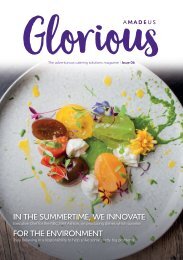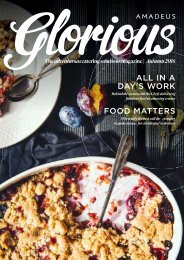EP Insights & Action
Expert observers comment on the Industry. This magazine is designed to bring together the thought leadership, ideas and opinions of leading consultants and operators from across the industry. EP's vision is to create an open narrative and debate that explains the perspective and thinking on the market and Industry. It will help all progress, so let us know your thoughts, subscribe and be involved.
Expert observers comment on the Industry. This magazine is designed to bring together the thought leadership, ideas and opinions of leading consultants and operators from across the industry. EP's vision is to create an open narrative and debate that explains the perspective and thinking on the market and Industry. It will help all progress, so let us know your thoughts, subscribe and be involved.
Create successful ePaper yourself
Turn your PDF publications into a flip-book with our unique Google optimized e-Paper software.
INSIGHTS THREAD CONSULTANCY<br />
unlikely that the operational and marketing<br />
specialists can achieve this entirely on their<br />
own. The solution is for both parties to<br />
work closely together – to develop creative<br />
concepts and promote to the workforce<br />
by understanding their behaviours and<br />
working patterns.<br />
The catering and hospitality sector can<br />
look once again to the retail sector for<br />
guidance to access markets and buyers<br />
effectively. First because they have embraced<br />
a move to “bricks and clicks” mentality, and<br />
adapted the way they operate to utilise digital<br />
platforms and technology to their advantage.<br />
and enable them to better manage their<br />
production and staffing levels.<br />
Second, in today’s marketplace, caterers<br />
are under increased price pressures. Now,<br />
when inflation has been at 2.9% since May,<br />
(and 2.6% in July) – the highest in nearly four<br />
years, and the cost of quality raw products<br />
is rising (through increased transport,<br />
production costs and fluctuating value of £),<br />
we’re seeing a situation that is intensifying the<br />
squeeze on household budgets and caterers’<br />
ability to deliver at multiple levels.<br />
It’s clear that operators can only offer<br />
competitive pricing to a certain level before<br />
disposable income, caterers must take care<br />
to offer choice, budget options and treats –<br />
as too many overpriced impulse buys is likely<br />
to lead to an increase in packed lunches<br />
from home, delivering a lack of footfall to the<br />
workplace dining room.<br />
Two key areas that<br />
must be improved are<br />
that of a more modern<br />
approach to implementing<br />
culinary development<br />
plans fully on the ground,<br />
along with effective<br />
product marketing.<br />
There are numerous ways catering operators<br />
can benefit from things such as online<br />
ordering to support them not only in engaging<br />
with their customers and gaining insights into<br />
when they think about their food and what<br />
appeals to them through website analytics,<br />
but also in contending with customer queues<br />
at peak service times. It can provide a whole<br />
new sales channel for operators through<br />
targeted marketing campaigns, allowing<br />
them to increase their capacity and sales<br />
without extending their footprint or resource,<br />
there is an impact on quality. Sophisticated<br />
menu engineering techniques should be<br />
applied to ensure menus are inviting and<br />
cost effective. Caterers must be able to<br />
demonstrate value to the customer, and<br />
where new innovative and freshly prepared<br />
concepts are visible, then the whole dining<br />
experience is valued and the possibility of<br />
repeat visits to the canteen far more likely.<br />
Competitively priced premium branded<br />
products are proven to grow average<br />
spends, but with the impending squeeze on<br />
© STYL<strong>EP</strong>HOTOGRAPHS | 123RF.COM<br />
Ultimately, in workplace catering as in<br />
retail, the responses from caterers must<br />
provide consumers with interactive and<br />
convenient experiences through storytelling<br />
and merchandising, and potentially using<br />
digital technology to allow them to browse,<br />
consider and buy whenever and wherever.<br />
By then targeting and personalising the<br />
food products and services to the customer’s<br />
specific wants and needs (where customers<br />
for example place more value on goods and<br />
services aligned with their individual values<br />
such as preferences for responsibly-sourced<br />
merchandise or local supply), operators<br />
can make employees feel connected to their<br />
workplace and its local community which in<br />
turn stimulates loyalty and habit.<br />
This cannot be achieved by caterers on<br />
the ground alone without specialist<br />
marketing support from research and<br />
segmentation through to integrated<br />
campaigns. It cannot be achieved by dated<br />
head office mass marketing designed to catch<br />
all – promoting all the options a customer<br />
could possibly want and forcing them to<br />
either wade through it or simply ignore it.<br />
After all, if we’re working harder, and feel<br />
more stressed than ever, the last thing any<br />
of us want is to work for our lunch and break<br />
times too.<br />
epmagazine.co.uk | 45
















